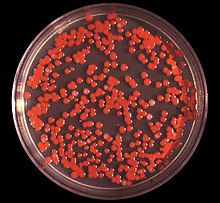| Serratia marcescens | |
|---|---|

| |
| Serratia marcescens on an agar plate | |
| Scientific classification | |
| Domain: | Bacteria |
| Phylum: | Pseudomonadota |
| Class: | Gammaproteobacteria |
| Order: | Enterobacterales |
| Family: | Yersiniaceae |
| Genus: | Serratia |
| Species: | S. marcescens
|
| Binomial name | |
| Serratia marcescens | |
Serratia marcescens (/səˈreɪʃiə mɑːrˈsɛsɪnz/)[3][failed verification] is a species of rod-shaped, Gram-negative bacteria in the family Yersiniaceae. It is a facultative anaerobe and an opportunistic pathogen in humans. It was discovered in 1819 by Bartolomeo Bizio in Padua, Italy.[4] S. marcescens is commonly involved in hospital-acquired infections (HAIs), also called nosocomial infections, particularly catheter-associated bacteremia, urinary tract infections, and wound infections,[5][6] and is responsible for 1.4% of HAI cases in the United States.[7] It is commonly found in the respiratory and urinary tracts of hospitalized adults and in the gastrointestinal systems of children.
Due to its abundant presence in the environment, and its preference for damp conditions, S. marcescens is commonly found growing in bathrooms (especially on tile grout, shower corners, toilet water lines, and basins), where it manifests as a pink, pink-orange, or orange discoloration and slimy film feeding off phosphorus-containing materials or fatty substances such as soap and shampoo residue.
Once established, complete eradication of the organism is often difficult, but can be accomplished by application of a bleach-based disinfectant. Rinsing and drying surfaces after use can also prevent the establishment of the bacterium by removing its food source and making the environment less hospitable.
S. marcescens may also be found in environments such as dirt and the subgingival biofilm of teeth. Due to this, and because S. marcescens produces a reddish-orange tripyrrole dye called prodigiosin, it may cause staining of the teeth. The biochemical pathway for the production of prodigiosin by S. marcescens has been characterized by analyzing what intermediates become accumulated in specific mutants.[8]
- ^ Biblioteca italiana, o sia Giornale di letteratura, scienze ed arti (in Italian). 1823. pp. 275–295. Retrieved 11 August 2019.
- ^ "Genus Serratia". List of Prokaryotic Names with Standing in Nomenclature (LPSN). Retrieved 6 June 2016.
- ^ Hicks, Randall. "Pronunciation Guide to microorganisms" (PDF). University of Minnesota.
- ^ Serratia marcescens. (2011, April). Retrieved from https://microbewiki.kenyon.edu/index.php/Serratia_marcescens
- ^ Hejazi A; Falkiner FR (1997). "Serratia marcescens". J Med Microbiol. 46 (11): 903–12. doi:10.1099/00222615-46-11-903. PMID 9368530. S2CID 12248893.
- ^ Auwaerter P (8 October 2007). "Serratia species". Point-of-Care Information Technology ABX Guide. Johns Hopkins University. Archived from the original on 14 April 2013. Retrieved 13 December 2008.
Freely available with registration.
- ^ Cite error: The named reference
Medscapewas invoked but never defined (see the help page). - ^ Williamson NR, Fineran PC, Gristwood T, Leeper FJ, Salmond GP (2006). "The biosynthesis and regulation of bacterial prodiginines". Nature Reviews Microbiology. 4 (12): 887–899. doi:10.1038/nrmicro1531. PMID 17109029. S2CID 11649828.